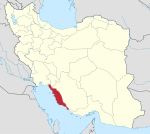Qaba Kolaki
Appearance
Qaba Kolaki
Persian: قباكلكي | |
|---|---|
Village | |
| Coordinates: 28°54′10″N 51°09′31″E / 28.90278°N 51.15861°E[1] | |
| Country | Iran |
| Province | Bushehr |
| County | Tangestan |
| District | Central |
| Rural District | Baghak |
| Population (2016)[2] | |
• Total | 1,022 |
| Time zone | UTC+3:30 (IRST) |
Qaba Kolaki (Persian: قباكلكي)[a] is a village in Baghak Rural District of the Central District in Tangestan County, Bushehr province, Iran.
Demographics
[edit]Population
[edit]At the time of the 2006 National Census, the village's population was 1,046 in 263 households.[4] The following census in 2011 counted 1,011 people in 289 households.[5] The 2016 census measured the population of the village as 1,022 people in 302 households.[2]
See also
[edit]Notes
[edit]References
[edit]- ^ OpenStreetMap contributors (6 March 2025). "Qaba Kolaki, Tangestan County" (Map). OpenStreetMap (in Persian). Retrieved 6 March 2025.
- ^ a b Census of the Islamic Republic of Iran, 1395 (2016): Bushehr Province. amar.org.ir (Report) (in Persian). The Statistical Center of Iran. Archived from the original (Excel) on 3 August 2017. Retrieved 19 December 2022.
- ^ Qaba Kolaki can be found at GEOnet Names Server, at this link, by opening the Advanced Search box, entering "-3757679" in the "Unique Feature Id" form, and clicking on "Search Database".
- ^ Census of the Islamic Republic of Iran, 1385 (2006): Bushehr Province. amar.org.ir (Report) (in Persian). The Statistical Center of Iran. Archived from the original (Excel) on 20 September 2011. Retrieved 25 September 2022.
- ^ Census of the Islamic Republic of Iran, 1390 (2011): Bushehr Province. irandataportal.syr.edu (Report) (in Persian). The Statistical Center of Iran. Archived from the original (Excel) on 3 April 2023. Retrieved 19 December 2022 – via Iran Data Portal, Syracuse University.


